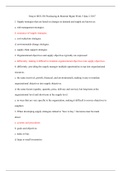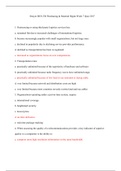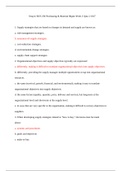Strayer BUS 230 Purchasing & Material Mgmt Week 3 Quiz 2 2017
Strayer BUS 230 Purchasing & Material Mgmt Week 3 Quiz 2 2017
All 3 results
Sort by

-
Strayer BUS 230 Purchasing & Material Mgmt Week 3 Quiz 2 2017
- Exam (elaborations) • 8 pages • 2019
-
- $15.49
- + learn more
1. Supply strategies that are based on changes in demand and supply are known as: 2. Organizational objectives and supply objectives typically are expressed: 3. When developing supply strategies related to “how to buy,” decisions must be made about: 4. Strategic planning can be defined as: 5. Three major challenges exist when setting supply objectives and strategies: 6. The key question in strategic supply management is: 7. Which one of the following is one of the six major supply strategy a...

-
Strayer BUS 230 Purchasing & Material Mgmt Week 3 Quiz 2 2017
- Exam (elaborations) • 4 pages • 2019
-
- $10.49
- + learn more
1. Supply strategies that are based on changes in demand and supply are known as: a. risk-management strategies. b. assurance-of-supply strategies. c. cost-reduction strategies. d. environmental-change strategies. e. supply chain support strategies 2. Organizational objectives and supply objectives typically are expressed: a. differently, making it difficult to translate organizational objectives into supply objectives. b. differently, providing the supply manager multiple opportunities to tap i...

-
Strayer BUS 230 Purchasing & Material Mgmt Week 3 Quiz 2 2017
- Exam (elaborations) • 8 pages • 2018
-
- $15.49
- + learn more
1. Supply strategies that are based on changes in demand and supply are known as: a. risk-management strategies. b. assurance-of-supply strategies. c. cost-reduction strategies. d. environmental-change strategies. e. supply chain support strategies 2. Organizational objectives and supply objectives typically are expressed: a. differently, making it difficult to translate organizational objectives into supply objectives. b. differently, providing the supply manager multiple opportunities to tap i...

That summary you just bought made someone very happy. Also get paid weekly? Sell your study resources on Stuvia! Discover all about earning on Stuvia


